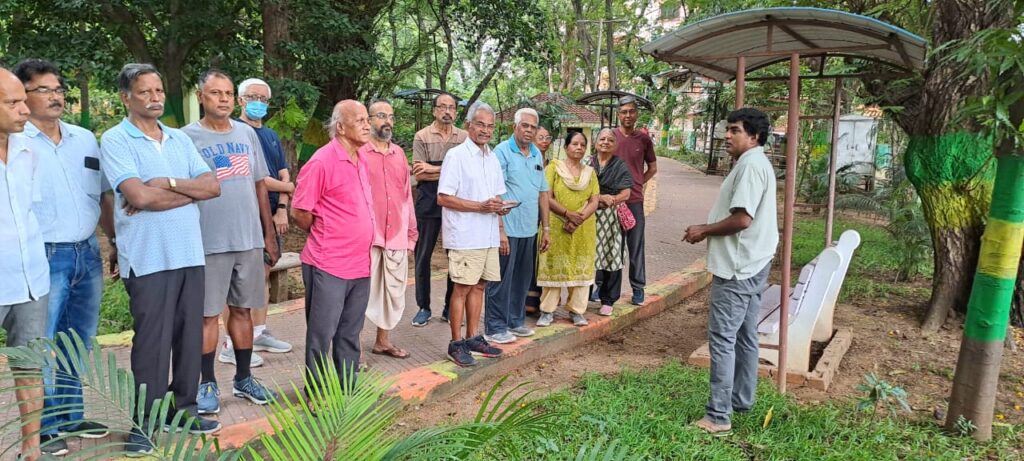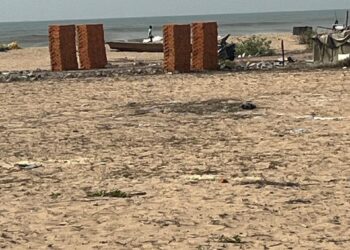By M.Rajini
Dr. T.D. Babu, a distinguished marine biologist with a specialisation in Animal Virology, has spent decades working to preserve and understand the intricate ecosystems of our coastal and marine environments. An alumnus of Vivekananda College and the University of Porto Novo, Dr. Babu’s career spins through various roles – from being a Farm Manager at a Coral Sea Farm in Tuticorin to contributing to major projects at the National Institute of Ocean Technology (NIOT). His work is deeply rooted in both science and social activism, with a focus on sustainable aquaculture, coastal management, and environmental education.
Beyond his technical expertise, Dr. Babu is a passionate advocate for environmental conservation, serving as a trustee of ‘Nizhal’, a member of the Green Committee of Chennai District, and an environment auditor for the Aqua Green Tribunal. His insights have influenced both policy and practice, especially in areas like mangrove protection, sand dune preservation, and sustainable fishing practices. Through his work, he has highlighted the need for greater awareness and action in safeguarding our coastal and marine resources.
In this exclusive chat, Dr. Babu shares his journey, observations, and the lessons he’s learned from his decades of experience working with marine species, environmental activism, and the urgent need for greater public engagement in protecting our natural resources. His closing philosophical quote, “Paropakarartham Idham Shariram” (This body is for the service of others), encapsulates his commitment to living a life dedicated to serving nature and society.
Tell us about your education Sir.
I did my schooling at The Hindu Senior Secondary School, Indira Nagar. Schools have a great impact on shaping our lives. We had a gardening club, wherein we were involved in maintaining a vegetable garden and shared the harvest. That was the first moment of pride where the seeds for love for greenery were sown. After high school, I forwent my MBBS dream as I didn’t want to pay the capitation fee, and went on to join Vivekananda College doing Marine Biology.
Your first Job…..
My first job was as a Farm Manager with Dr. M.Shakthivel, Chairman of MPEDA (Marine Products Export Development Authority) at Coral Sea Farm, spread over 404 acres at Vaippar, Tuticorin. The place was full of salt pans and seemai karuvelam (an invasive species of tree used for firewood). There, I learnt the art of culturing prawns in man-made earthen ponds. Constructing ponds in sandy areas is a challenge as they are permeable. Compacting the sides with clay was costly, and we didn’t have tarpaulin sheets those days. I tried lining the wall with palm leaves, tied it with coir and pinned it with karuvelam. It worked like a charm. It was not only eco-friendly but also provided the local women with a livelihood.
One harvest took one and a half years. Shrimps are nocturnal creatures and I spent a lot of nights talking to them and sleeping under the stars on the bunds! It was an exhilarating experience where I connected with the ocean and saw the changing pattern of the shore, tides, currents etc. The coast became my companion.
In 1996 I joined my mentor at the Aquaculture Foundation of India, Neelankarai, as a Technician and Technical writer. At Mysore Feeds Ltd, Bangalore, a Feed manufacturing company, I was involved in feed formulation and production for cultured shrimps and fish, so we could create our own indigenous feed. Till then, all feeds were imported by India, mainly from Thailand.
When did you come to NIOT?
At NIOT, I was part of the ‘Living Marine Source Enhancement for Island Development’ mission focusing on marine lobsters. Lobsters are valued according to their weight. Thus, the tiny catches (75 gms) are discarded. Our mission was to try and grow these tiny lobsters with natural feed (worms and green Mussels) till they grew to the required weight, thus reducing waste. This work was done at a wet lab at Kapaleeswarar Nagar, Neelankarai, where we had large deep tanks replicating their natural environment (lobsters are usually found in the depths of the ocean floor and require a lot of water pressure for growth and reproduction). We were happy to see the growth of healthy lobsters there. I was on this mission for four and a half years.
What were your observations in the aftermath of the Tsunami?
In 2005, the Coastal Aquaculture Authority (CAA) wanted to do a survey and report on the ‘Impact Assessment of Tsunamis’ on coastal villages and Aquaculture. Late. Dr. P.Nammalwar, Former Principal Scientist, wanted me to do this. It was a great opportunity to study the coastal profile of TN.
Wherever mangroves and sand dunes were standing guard there were no casualties. While the locality of Karikaattu Kuppam, which had largely encroached into the shore, was devastated totally; the Jambalodai, which was 700 m away from the shore with undisturbed surroundings, was untouched. Dunes give a contour or a slope to the surface, which makes the water slide over it and lose its intensity, diminishing the disaster. Dunes are our coastal guardians.
In Injambakkam, adjacent to M.K.Radha Salai, there is a wetland. Recently, CMDA has flattened out all the dunes to make way for some development programmes, despite knowing that it is an ecologically sensitive area. Do you know how many years it takes for a natural dune to be formed as a first line of defence? Isn’t it atrocious to raze it away in a day?
Why doesn’t anyone question this?
Who is aware of the consequences? When we enter a wooded place, there are warning posts with essential information for the visitors, but there are no such posts placed on our beaches indicating that it is part of the sensitive Coastal Regulatory Zone (CRZ). I have observed that wherever the coastal ecosystem was not disturbed there was no danger to habitat or lives.
How many are aware of OSR land and that it belongs to the community? Lack of awareness among the public is the main cause of encroachment of our rights.
Why is there so much encroachment on the coast?
Earlier there used to be fishing hamlets under Grama Natham. Fishing communities were entitled to live in these hamlets for generations. When politicians started giving them pattas in individual names (for their own political mileage), trouble started. People started to encash it. How else do you see concrete structures along the shore by outsiders?
It is an irony when people or even scientists talk about the ocean invading the land. It is actually we who are encroaching on the sea.
Are there people who take environmental safety seriously?
A handful maybe. Dr.Vijayakumar, IAS, a veterinarian who was the Regional Deputy Commissioner (South Chennai), distributed copies of the Tamil magazine Vikatan that carried an article on Ridley Turtle Conservation. But, sadly such people just disappear, unable to carry on their good work. Ultimately, it is the people who should take the initiative and take a stand. After all, it is a question of our survival.
What can be done to inspire youngsters?
We are conducting Tree walks, coastal walks, heritage walks etc. But creating awareness alone will not work. They must graduate to the next level of Action. I joined Nizhal only as a participant, but now I am a Trustee in it. I found like-minded people and was levered to take action. It is not enough to have knowledge of trees and know their names. You should have a passion to serve; take care of the trees in your street, or at least stop tree abuse. Local bodies should involve the community in their projects.

As a State Coordinator for the Network for Fish Quality Management and Sustainable Fishing, which falls under the Ministry of Commerce, I had to verify the licenses for fishing boats, ensure that they don’t use equipment that harms fish, and ensure hygienic practices in fishing, handling and preserving the catch. I was horrified at seeing the inhumane conditions in the fish market.
National Centre for Sustainable Coastal Management (NCSCM) Ministry of Environment and Forest and Climate Change, has submitted a report to Ministries, noting the spots where the coastline is inundated and vulnerable for being submerged in the sea. It has been mapped out. You will be shocked to hear that there is real estate happening now in such vulnerable zones.
“Paropakarartham Idham Shareeram”. The entire life cycle of every tree, every river is only service. Likewise, Man, with 6 senses, has been created by God only to serve others. We should remember that and coexist with Nature and its creations.
To our readers…
Culture can be inherited only through grandparents and not parents, is my firm belief. To the young generation, I would say: Do not ignore the treasure trove of experiences of the older generation. They revolved around 3 S – Sharing, Serving and Societal love. The present generation is mostly – Self, Selfie and Selfish.
T.D Babu resides at Sastri Nagar and can be contacted at 98841 14721 or [email protected].












